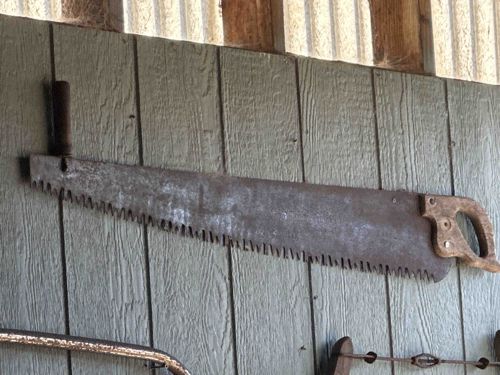
Two-Person Crosscut Saw
This is an antique or vintage two-person logging saw, also known as a crosscut saw or 'misery whip,' designed for felling trees or bucking logs. The saw features a long, tapering steel blade, showing significant signs of age and wear. The blade is heavily patinated with a dark, mottled rust covering much of its surface, indicative of prolonged exposure to the elements and lack of maintenance. Despite the rust, the individual teeth appear relatively intact along both cutting edges, suggesting a 'raker' or 'lance tooth' pattern, common for efficient cutting of large timber. One end of the blade is fitted with a fixed, stout, dark-colored handle, likely made of wood or cast iron, cylindrical in shape. The other end terminates in a more elaborate, open-grip wooden handle, secured to the blade with at least two visible rivets or bolts. This wooden handle exhibits a lighter, weathered appearance, possibly oak or similar hardwood, with a classic D-shaped grip allowing for a firm hold. No discernible maker's marks, stamps, or significant engravings are visible on the blade or handles due to the heavy patina and distance. The overall condition suggests that while it was once a functional tool, it now serves more as a decorative or historical artifact, displaying its working life fully. The substantial length and dual-handle design indicate its purpose in heavy-duty lumbering operations, likely dating from the late 19th to early 20th century when such manual logging tools were widely used before the advent of chainsaws. The craftsmanship reflects durable, utilitarian construction typical of tools built to withstand rigorous outdoor work.
AI-Generated Appraisal Disclaimer
Estimated Value
$150-250
Basic Information
Category
Hand Tool
Appraised On
November 28, 2025
Estimated Value
$150-250
Item Description
This is an antique or vintage two-person logging saw, also known as a crosscut saw or 'misery whip,' designed for felling trees or bucking logs. The saw features a long, tapering steel blade, showing significant signs of age and wear. The blade is heavily patinated with a dark, mottled rust covering much of its surface, indicative of prolonged exposure to the elements and lack of maintenance. Despite the rust, the individual teeth appear relatively intact along both cutting edges, suggesting a 'raker' or 'lance tooth' pattern, common for efficient cutting of large timber. One end of the blade is fitted with a fixed, stout, dark-colored handle, likely made of wood or cast iron, cylindrical in shape. The other end terminates in a more elaborate, open-grip wooden handle, secured to the blade with at least two visible rivets or bolts. This wooden handle exhibits a lighter, weathered appearance, possibly oak or similar hardwood, with a classic D-shaped grip allowing for a firm hold. No discernible maker's marks, stamps, or significant engravings are visible on the blade or handles due to the heavy patina and distance. The overall condition suggests that while it was once a functional tool, it now serves more as a decorative or historical artifact, displaying its working life fully. The substantial length and dual-handle design indicate its purpose in heavy-duty lumbering operations, likely dating from the late 19th to early 20th century when such manual logging tools were widely used before the advent of chainsaws. The craftsmanship reflects durable, utilitarian construction typical of tools built to withstand rigorous outdoor work.
Related Tags
Explore similar items and categories:
Get Your Items Appraised
Instant estimates of your treasures with AI-powered instant appraisals